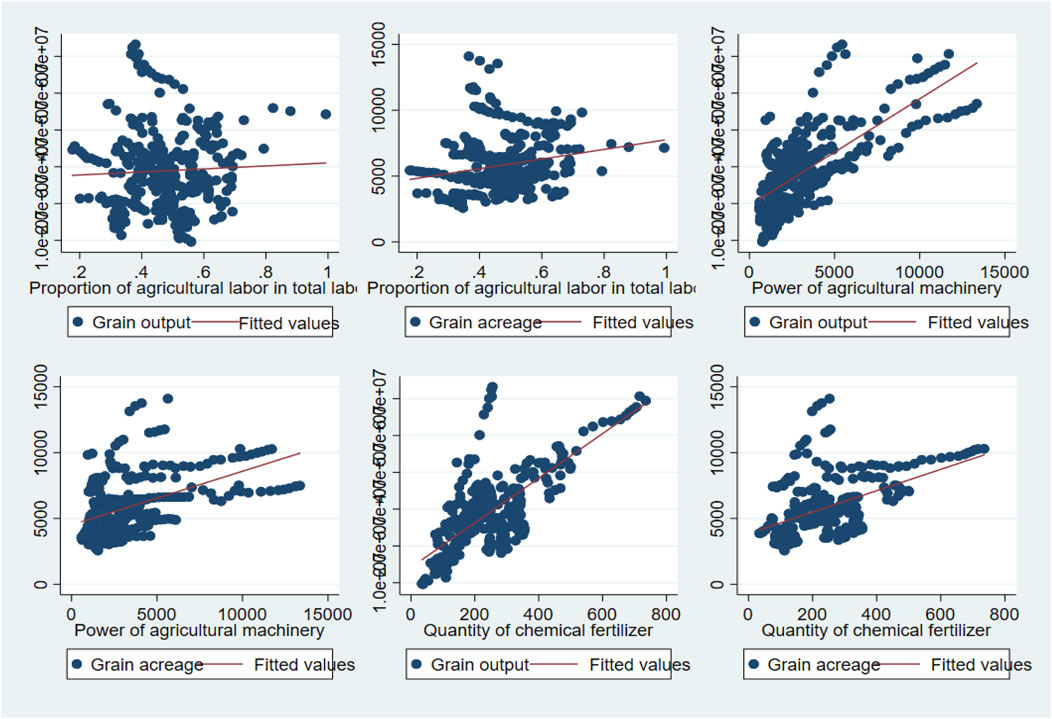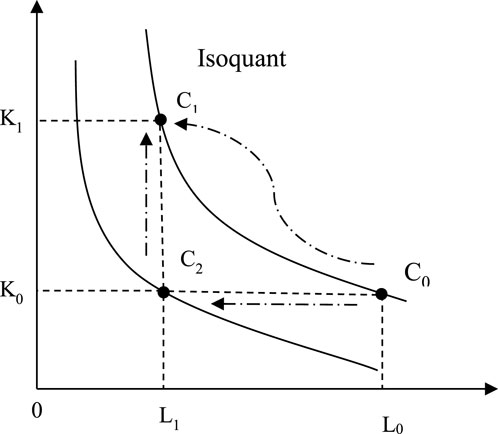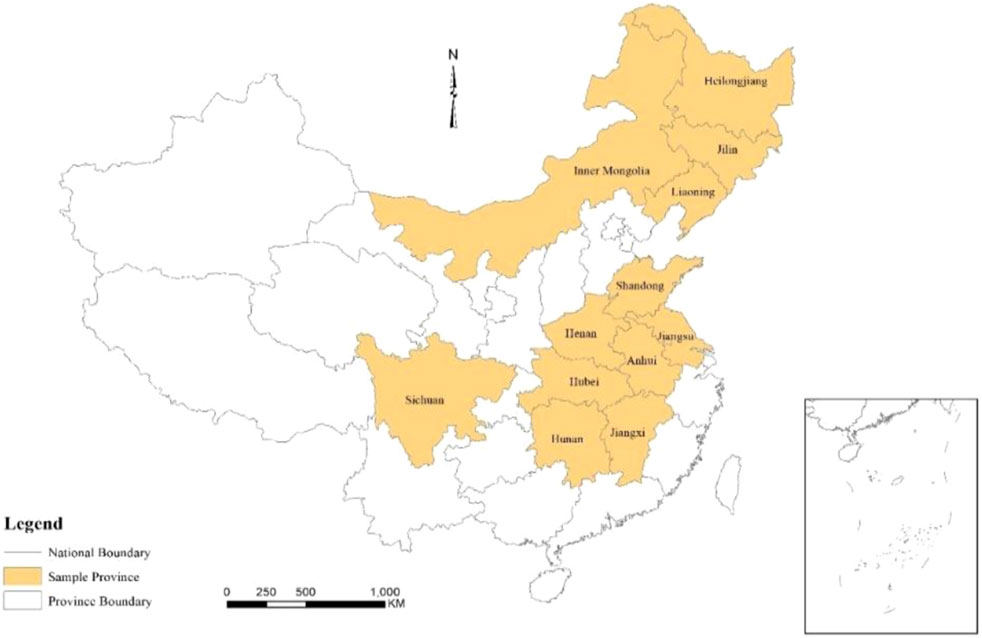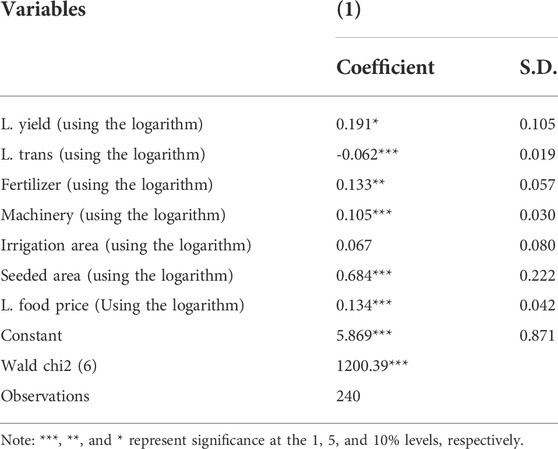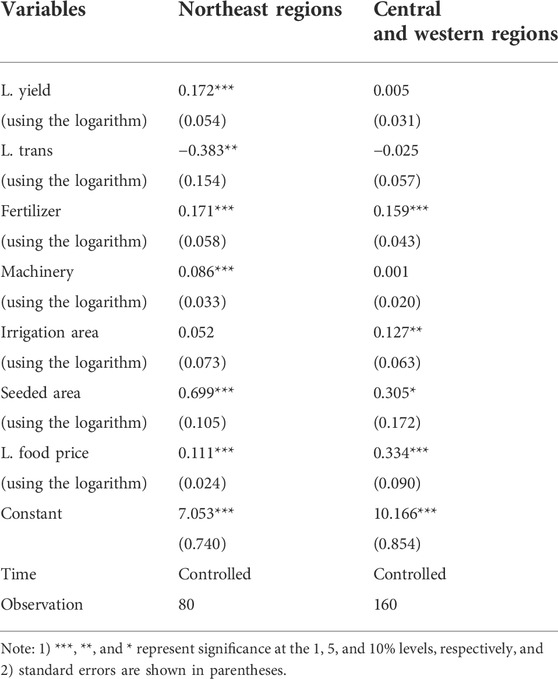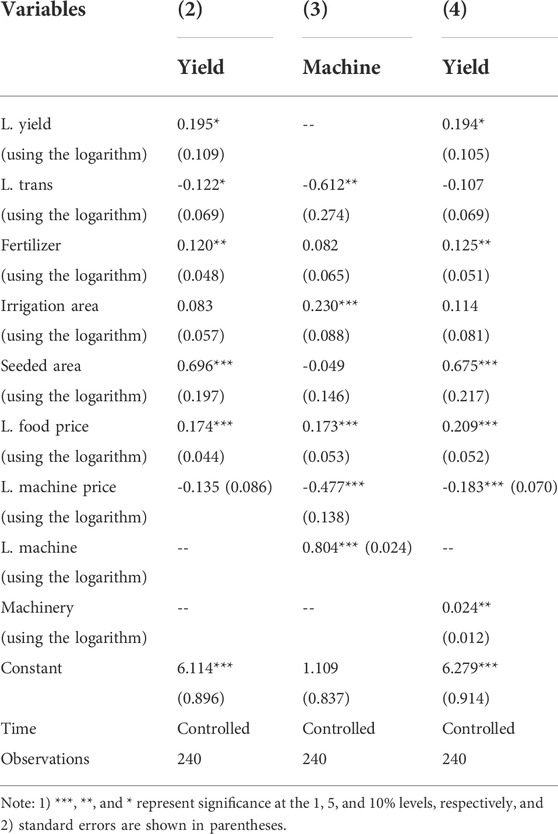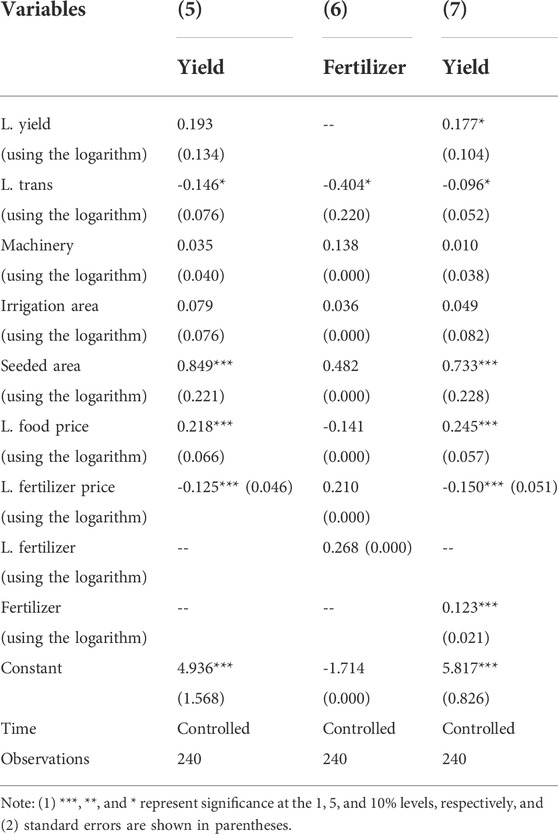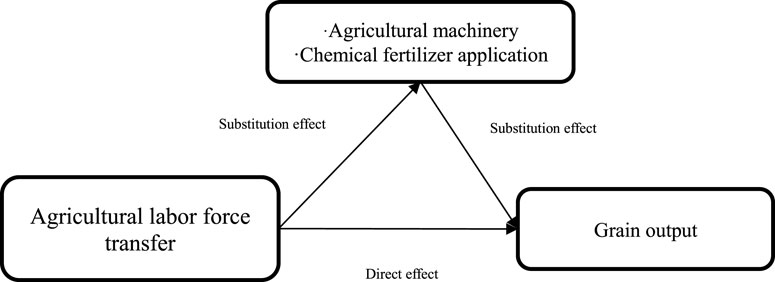- 1Institute of Ecological Civilization, Jiangxi University of Finance and Economics, Nanchang, China
- 2Office of International Cooperation and Exchange, Jiangxi University of Finance and Economics, Nanchang, China
The continuous increase in China’s grain output has significantly contributed to food security and poverty alleviation worldwide. Whether the massive nonagricultural transfer of the agricultural labor force in China could affect grain production and the extent of the effects of such changes have become important practical issues. By using panel data from major grain-producing provinces in China from 1995 to 2017 and based on farmer behavior theory, this paper constructs an econometric model and a mediation effect model to empirically test the influencing mechanism and causal relationship between agricultural labor force transfer (ALT) and grain output from the substitution perspective of chemical fertilizer and agricultural machinery application. The findings reveal that ALT has no substantial negative impact on China’s grain output but is conducive to promoting grain production. ALT can directly promote grain production and partially promote it through the use of agricultural machinery and the application of chemical fertilizers as mediation variables. These findings have important policy implications for promoting grain production and the nonagricultural transfer of the agricultural labor force in China. Moreover, this work can improve the international community’s understanding of the seventeen consecutive increases in China’s grain output and provide a reference for grain production worldwide. In the future, a heterogeneity analysis can be carried out in grain main-marketing areas and producing and marketing balance areas in China, and the relationship between agricultural machinery and the environment is worthy of further studies.
Introduction
The Chinese population accounts for nearly one-fifth of the total population worldwide, and the grain output accounts for one-fourth of the total. A historic transformation has been achieved from “not enough to eat” to “eat enough” and “eat well”, and China has helped its rural poor people resolve the problem of “not worrying about eating” and significantly contributed to food security and poverty alleviation worldwide (The State Council Information Office of the People’s Republic of China, 2019). Currently, Chinese urbanization is accelerating. In 1978, the urbanization rate of the permanent resident population was only 17.9%, whereas by the end of 2018, it reached 59.6%, and the urbanization rate of the registered population also increased to 43.37%. With continuous improvement in economic growth and urbanization in China and driven by economic interests, the nonagricultural transfer of the agricultural labor force is inevitable (Lu et al., 2019a). The production of grain and all types of agricultural products requires labor. Will China’s grain output be affected by the massive agricultural labor force transfer (ALT)? If so, to what extent and in what ways? These important realistic problems concerning grain production and poverty alleviation worldwide have become important issues in academic circles.
China’s rural‒urban population migration will continue to be active. By 2020, China’s migrant population will gradually increase to 291 million, the agricultural labor transfer population will total 220 million, and family migration will continue to increase (National Health and Family Planning Commission floating population division, 2018). According to the theory of induced institutional innovation, the relative scarcity of effective labor in agriculture will induce farmers to make adaptive adjustments and choose relatively abundant resources to replace scarce resources (Ruttan and Hayami, 1984). Among agricultural factor inputs, labor and capital have certain substitutability (Binswanger, 1974). Many scholars are deeply concerned with the impact of ALT on China’s grain production (Rozelle et al., 1999; Li and Zhao, 2009). However, since 2004, the trend of increasing grain output in China has not decreased with ALT. In contrast, the grain output continued to increase (referred to as seventeen consecutive increases), and the grain acreage continued to rise. In 2018, the per capita share of grain output in China reached approximately 470 kg, which was higher than the world’s average, and the grain acreage reached more than 117 million hectares (The State Council Information Office of The People’s Republic of China, 2019). Did this phenomenon occur because ALT does not affect grain production or because other factors conducive to grain production offset its effect?
A deep analysis of the above issues and the production of reasonable explanations are helpful for deepening the international community’s understanding of China’s grain production laws. Currently and in the future, grain production and its control policies in China will face enormous challenges, such as the rising cost of producing grain, the COVID-19 crisis, tighter resource constraints and international pressure on grain imports, which have greatly reduced China’s control policies on grain production. However, in the face of such large challenges, grain output has achieved seventeen consecutive increases in China. What is a reasonable explanation for these increases? Several discussions and continuous studies have been performed concerning the impact of ALT on grain output in China; however, a consensus has not been reached. Zheng et al. (2014) revealed that urbanization has also had a profound impact on grain production as it promoted the reallocation of arable land and labor resources among sectors. A large number of ALTs will not substantially affect grain production (Du and Li, 2019). Farmers can produce more food that requires less labor input and is easily replaced by machinery (Lu et al., 2018) or adjust the planting proportion of food crops and nonfood crops to cope with the impact of ALT (Lin and Li, 2013; Wang et al., 2014). Zhong et al. (2016) found that ALT would lead farmers to increase mechanical inputs and expand grain acreages, thereby increasing grain output. Some scholars also hold different opinions and believe that ALT in China will have a negative impact on grain production (Li and Zhao, 2009; Qin et al., 2011). Although ALT will increase household income and ease the constraints of capital on agricultural production, it cannot offset the negative impact of ALT on grain production (Qian and Zheng, 2010; Gonzalez-Velosa, 2011). ALT will also promote the circulation of agricultural land and rural-household differentiation, leading to the transformation of the agricultural production mode in China (Chang and Mishra, 2012; Long and Ren, 2016; Lu et al., 2018). Under the condition of low-profit grain production, the agricultural operators who transfer into land often choose to plant cash crops; thus, the planting area of grain crops decreases (Qiu and Luo, 2018). Additionally, infectious diseases are an important factor affecting China’s grain production. Li et al. (2021) confirmed that COVID-19 had a great impact on travel, which, in turn, affected agricultural labor mobility and grain production. Previous studies have provided the basis for this paper, although further in-depth analysis is still needed. The possibilities are as follows. First, most studies did not quantitatively test the effect of ALT and the factor substitution caused by it on China’s grain production and did not consider the influence degree. This study adopts an econometric model to perform quantitative estimations. Second, with the continuous promotion of urbanization in China, ALT is inevitable. Considering the influence of the substitution of agricultural production factors on grain production is conducive to clarifying the contribution of different agricultural production factors in grain production and providing a new explanation for the growth of China’s grain production.
In recent years, China has proposed a new grain security concept of “ensuring basic self-sufficiency in grain and absolute security of grain rations”. The impact of continuous ALT and the substitution of agricultural production factors on China’s grain production have become important issues of concern at all levels of government and theoretical circles. Under the background of the rising cost of agricultural production factors in China, this study focuses on the impact of ALT on grain production and its influencing mechanism. During the process of urbanization and rural revitalization in China, does ALT have a negative effect on grain production? If so, how large is this effect? If the negative impact of ALT on grain production is very small, it will have a negligible impact on grain production or food security, and measures to promote ALT and, thus, improve the urbanization rate can continue. In addition, ALT will induce farmers to use agricultural machinery or fertilizers to replace labor. Over the past 30 years in China, the contribution of ALT and the resulting effect of using agricultural machinery and chemical fertilizers on China’s grain production must be clarified. Moreover, the changing trend in the use of agricultural machinery and consumption of chemical fertilizers for the replacement of the agricultural labor force must be determined. Through theoretical analyses and empirical tests, this study explains the path of the grain production increases in China and objectively and accurately evaluates the influencing path and degree of the impact of ALT on China’s grain production. This study could also help increase the international community’s understanding of the continuous increase in China’s grain output and provide a reference for global grain production. In addition, this study provides a research perspective for scholars studying the substitution or complementarity relationship between agricultural machinery and chemical fertilizer application and its impact on grain production or the agricultural environment.
Background and theoretical analysis
Development of ALT, agricultural machinery, chemical fertilizers and grain output in China
The most direct substitute for labor input in agricultural production is the use of agricultural machinery. Mechanization, as a typical labor-saving technology, can reduce the labor time and improve labor productivity. In the context of rising agricultural labor prices in China, the relative prices of machinery and changes in labor, mechanization has become a key choice in China to solve shortages in the agricultural labor force. However, the use of machinery requires an appropriate cultivated land scale and topographic conditions. The characteristics of resource endowment with a large population and small land area and the fragmentation and diversification of cultivated land in China could restrict the rapid advance of mechanization for a long time. In addition, chemical fertilizers and other chemicals represent a typical land-saving technology. In hilly and mountainous areas where agricultural machinery is difficult to use, farmers tend to reduce the number of fertilizer applications and increase the amount of chemical fertilizers applied each time to compensate for the adverse impact of the agricultural labor supply shortage and generate a substitution effect for ALT. Figure 1 shows that the proportion of agricultural labor among China’s total labor force declined from 82% in 1990 to 60% in 2017. Furthermore, the application of chemical fertilizers and the total power of agricultural machinery are increasing. The amount of chemical fertilizers used increased from 25.903 million tons to 58.594 million tons in the same time period, with an average annual growth rate of 4.92%. The total power of agricultural machinery increased from 287.08 million kilowatts to 987.833 million kilowatts, with an average annual growth rate of 7.5%. The average annual growth rate of agricultural machinery is higher than that of chemical fertilizers.
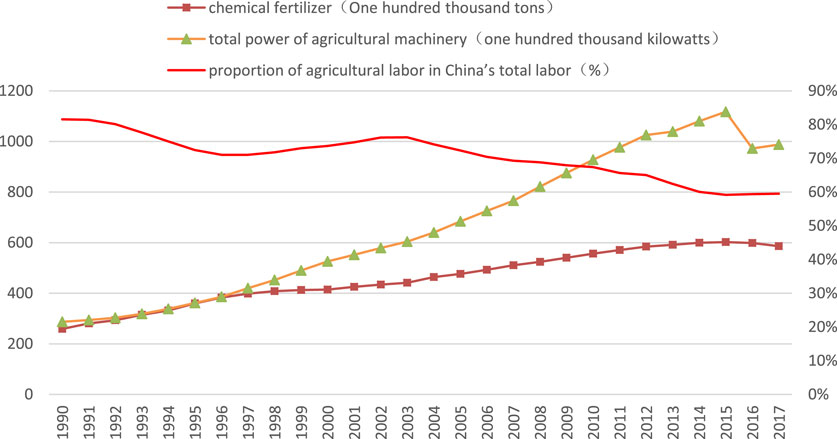
FIGURE 1. Change trend in ALT, fertilizer application and total power of agricultural machinery (1990–2017).
Since 2003, the proportion of agricultural labor in the total labor force in China has been declining. However, China’s grain output has achieved thirteen consecutive increases. ALT does not seem to have caused any substantial damage to grain output, which has presented sustained increases in production under the condition that neither the scale of cultivated land per household nor the scale of land plot has substantially expanded. Figure 2 shows that the increasing trend of grain output and grain acreage in China is more closely related to the power of agricultural machines and the quantity of chemical fertilizer and less related to the proportion of agricultural labor in the total labor force. As the scale of ALT expands, the rigid constraint of labor input in agricultural production is constantly strengthened, and crops (such as grain crops) that need less labor input and are easily mechanized will have a comparative advantage in planting. The rapid transfer of agricultural land management rights in China will also promote an increase in large-scale farmers. To save agricultural labor inputs, farmers will also tend to plant grain crops for which labor can be easily replaced. Currently, Chinese agricultural socialized services are mainly machinery services. Farmers whose main labor force is engaged in nonagricultural work will also choose to plant more crops that are easily mechanized based on the characteristics of social service supply. Therefore, ALT will lead to an increase in the proportion of food crops planted.
Furthermore, according to the Spearman correlation analysis (Table 1), the correlation coefficients between ALT and the total agricultural machinery power, chemical fertilizer application, grain yield and grain sown area are significantly negative at the 1% level, and the coefficients are strong. Thus, there is a strong negative correlation between ALT and factor substitution and grain output. However, a Spearman correlation coefficient between two variables does not indicate that there is a causal relationship. In this paper, according to the theory of induced institutional innovation and the theory of farmer behavior, ALT will drive farmers to adopt labor-saving agricultural technology, such as agricultural machinery or chemical fertilizers. Therefore, econometric models are needed to determine whether ALT will affect grain production through factor substitution.

TABLE 1. Spearman correlation coefficient between ALT, chemical fertilizers and agricultural machinery and grain output.
Theoretical analysis
China’s agricultural development has been evolving along the direction of capital savings and labor intensity, which has greatly increased the agricultural production efficiency and agricultural output in a certain period. As the opportunity cost of agricultural labor continues to rise, intensive farming in a household is neither economical nor consistent with the needs of market-oriented agricultural development. According to the theory of induced technological change, labor, capital and technological input are complementary or substitutive (Ruttan and Hayami, 1984). The relative scarcity of the agricultural labor force will induce farmers to make adaptive adjustments by adopting agricultural machinery technology (M technology), which saves labor input, and biochemical technology (BC technology), which saves land input. M technology can effectively reduce farmers’ extensive agricultural management caused by agricultural labor shortages and improve the factor utilization rate. BC technology can save land and improve land productivity. Therefore, the impact of agricultural labor transfer on grain production will also be affected by the application of agricultural machinery and chemical fertilizers by farmers.
According to the hypothesis proposed in the Lewis model, i.e., the marginal output of rural surplus labor is zero or negative, the transfer of the surplus agricultural labor force should not affect agricultural production; however, Schultz does not agree with the “zero value agricultural labor hypothesis” and suggests that agricultural labor is not homogeneous but rather heterogeneous. Human capital is the ultimate source of agricultural economic growth, and the loss of human capital will affect agricultural production (Schultz, 1964). Agricultural production has seasonal characteristics. The sowing, fertilization, irrigation and harvesting of various crops all follow certain time rules, and agricultural labor is divided into different time periods. Farmers need to invest in agricultural production factors according to seasonal characteristics and time laws of agricultural production. In reality, China has a large number of part-time laborers who are engaged in nonagricultural employment in addition to farming (Chen, 2018); these individuals “do farm work during the busy season and do off-farm work during other times”. Chinese people have always emphasized the importance of “not missing the time of farming” in agricultural production (Chen, 2019). When the agricultural labor force cannot be engaged in labor according to farming time rules, labor inputs and grain outputs will be affected. During the busy season of agricultural production in China, the shortage of agricultural labor supply may have an impact on grain production.
According to the theory of producer behavior in microeconomics (Figure 3), a reduction in the agricultural labor force from L0 to L1 will lead to a reduction in grain output from C0 to C2. Furthermore, according to the diminishing law of the marginal technology substitution rate and the prediction of the Lewis model, if the off-farm income generated by ALT can “feed-back” to agriculture, such as buying machinery, applying high-yielding seeds or chemical fertilizers, the C2 point on the isoquant curve will rise to the C1 point while keeping the L1 of the agricultural labor force unchanged. Thus, under the replacement of agricultural machinery or chemical fertilizers, a reduction in the agricultural labor force will not have a substantial impact on grain output. Therefore, whether grain output can be restored to the C0 level depends on the substitution ability of agricultural machinery or chemical fertilizers and the adjustment capacity and willingness of farmers.
Model, variables and data
Model
To verify the influencing mechanism and causality of ALT and factor substitution on grain output, this paper constructs the following dynamic panel data model:
where
In recent years, the stepwise regression method of the mediation effect test proposed by Baron and Kenny (1986) and the mediation effect test model proposed by Wen and Ye, 2014 have been used to constructs the following mediation effect model to verify the indirect effect of agricultural machinery and chemical fertilizer application on grain production:
where
This paper focuses on the following mediation effect: whether ALT can promote grain output by promoting the use of agricultural machinery and chemical fertilizer application. The dependent variable is grain output, the independent variable is ALT, and the intervening variables are agricultural mechanization and chemical fertilizer application.
Variable selection
According to Petty-Clark’s theorem, with the development of the economy and improvement in the per capita income level, the labor force will transfer from primary industry to secondary industry and then tertiary industry (Yu, 1996). Based on the data availability and the objective law of ALT in China, this paper selects the proportion of the agricultural labor force in the total labor force as a proxy variable for ALT, and the agricultural labor force is expressed by the number of employees in the primary industry.
Second, according to the general practices observed in the literature, this paper adopts the total power of agricultural machinery and the amount of chemical fertilizers to measure the factor substitution of farmers. The total power of agricultural machinery can comprehensively reflect the degree of mechanization in agricultural production and its investment status, and the net amount of chemical fertilizers applied reflects the amount of chemical fertilizers applied by farmers.
Finally, on the basis of the above core variables, this study further controlled the influence of other variables, such as the effective irrigated area and the retail price index of food commodities. The impact of possible missing variables is mainly corrected by the differential generalized method of moments (GMM).
Data source and data description
Because of the absence of price data of fertilizer and agricultural machinery before 1995, the data used in this paper are from panel data from 13 major grain-producing provinces in China from 1990 to 2017 (Figure 4). From 1997 to 2003, China’s grain output decreased yearly, and the grain acreage in 2003 decreased to the lowest value since the founding of the People’s Republic of China. Under the pressure of food security and in accordance with the principle of comparative advantage in agricultural production, the Chinese government established major grain-producing areas, major grain-marketing areas and balanced production-marketing areas in 2004. In China, the major grain-producing provinces include Liaoning, Hebei, Shandong, Jilin, Inner Mongolia, Jiangxi, Hunan, Sichuan, Henan, Hubei, Jiangsu, Anhui and Heilongjiang. Many grain production resources and agricultural policies also tend to target the main grain-producing areas. In 2021, the grain output in major grain-producing provinces accounted for 78.5% of China’s total grain output. Therefore, choosing the main grain-producing province to study grain yield has a better representation in the study of grain production. Due to the lack of data in Hebei Province, this province was not included in the data analysis.
The data of the total grain output, total grain acreage, number of employees in the primary industry, total number of employees, and net amount of chemical fertilizer application were all obtained from the China Rural Statistical Yearbook (1996–2018).
Since China’s statistical yearbook does not include data of the increase in the total mechanical power, fertilizer application and effective irrigation area of grain crops, this paper primarily refers to previous research and conducts the following processing:
Agricultural machinery power for food crops = (Grain acreage ÷ Total sown area of crops) × Total power of agricultural machinery;
Chemical fertilizer application of food crops = (Grain acreage ÷ Total sown area of crops) × Total application of agricultural chemical fertilizers; and
Effective irrigation area for food crops = (Grain acreage ÷ Total sown area of crops) × Effective irrigated area for crops.
The results of descriptive statistical analysis of the main variables are shown in Table 2.
Results
Empirical results
China’s grain production and ALT affect each other, resulting in endogenous problems, and the estimated results by the ordinary least squares (OLS) method and the fixed effect models will be biased. According to the theory of household behavior, farmers will determine their current agricultural production decisions based on the previous agricultural output. In this model, the dependent variable is processed with a one-period lag. To verify the existence of the effect of factor substitution, the proxy variable for ALT is also treated with a one-period lag. In this study, GMM was used to overcome the bias in the estimation results caused by endogeneity.
In this study, grain output was used to estimate the independent variables, such as ALT, total agricultural machinery power and chemical fertilizer application, and the effect of the lag term dependent variable was considered. GMM estimation is divided into system GMM and differential GMM. In general, system GMM may have the problem of the overidentification of instrumental variables. In this paper, differential GMM was selected for the estimation. The Wald statistic of the model is significantly positive at the 1% level, indicating that the overall estimation results of the model are good and have strong explanatory ability.
The proportion of the agricultural labor force in the total labor force is used as a proxy variable for ALT. Table 3 shows that the effect of ALT on grain output is significantly negative at the 5% level, indicating that the transfer of the agricultural labor force in China has no substantial impact on grain output but is conducive to promoting it. The impact of the use of agricultural machinery on grain output is significantly positive at the 5% level; thus, increased grain output can be directly promoted by agricultural mechanization or realized by the replacement of the agricultural labor force. The effect of chemical fertilizer application on grain output is positive, and such application could significantly promote grain output growth in China. The effect of the lag term of grain output is significantly positive, indicating that there is a certain inertia in grain production in China, suggesting that farmers’ current production decisions will be affected by previous output. The grain production of farmers in China has the characteristics of risk aversion. If grain production in the previous period is relatively stable, the grain planting of farmers in the current period will be stable or slightly increased. The price of agricultural products has a significant positive impact on China’s grain output. Price provides important information that influences whether farmers expand the cultivation of grain crops. The rising price of agricultural products will increase agricultural profits, and farmers will be more motivated to grow grain crops. This conclusion is consistent with the conclusion by Lu et al. (2019b). The effect of grain acreage on grain yield was significantly positive, indicating that more grain acreage will lead to greater grain output.
Agricultural production has seasonal characteristics. The sowing, fertilization, irrigation and harvesting of various crops all follow certain time rules. According to the time rules in agriculture, the agricultural labor force will allocate the labor time between agricultural production and off-farm employment. If the income from off-farm employment is still higher than that from farming (especially the income from grain planting), the nonagricultural transfer or part-time employment of the agricultural labor force will be the rational choice for farmers. Off-farm employment can directly increase household income, alleviate the financial constraints of agricultural production, and increase the convenience of purchasing chemical fertilizers, agricultural machinery or agricultural machinery services, and the agricultural labor force replacement capacity will be stronger during the busy farming season. The above conclusion and discussion show that ALT, agricultural mechanization and chemical fertilizer applications will have a positive impact on China’s grain production. Whether ALT is conducive to the increase in grain production in China or whether the associated agricultural mechanization and chemical fertilizer application offset the negative impacts of ALT on China’s grain production should be analyzed to determine the mediation effect.
Empirical results in different regions in China
To account for regional differences in the above issues and provide robust tests, the samples were divided into northeast regions and central and western regions in China according to the regional distribution and sample size characteristics of China’s major grain-producing provinces. The estimation results are basically robust, although there are some regional differences (Table 4). From the perspective of agricultural labor transfer variables, ALT has a significant impact on grain output in northeast China but a negative and nonsignificant impact on grain output in the central and western regions in China. Thus, ALT will promote grain output in northeast China. The impact of applying chemical fertilizers was significant in both the northeast and the central and western regions, indicating that chemical fertilizers had an obvious promoting effect on China’s grain output, although the regional differences were not obvious. The impact of agricultural mechanization is significant in the northeast region, and the central and western regions are mainly hills and mountains. Therefore, agricultural mechanization cannot be implemented and used in a wide area, and the influence of this variable is not significant. If there is a mediating effect of chemical fertilizer application and agricultural machinery on ALT, it should be more obvious in northeast China. The effective irrigation area is significant in the central and western regions but not in the northeast region likely because the terrain in the northeast region is flat, and effective irrigation is basically available in the grain-growing regions. However, farmland in many areas in the central and western regions cannot be effectively irrigated due to terrain restrictions. Irrigation will become a key factor affecting grain growth in the central and western regions of China. The food price and seeded area in the previous year had significant positive effects on the grain output in different regions, and regional differences were not obvious.
Mediation effect test
According to the above model, Stata 15.0 (Stata Corp LLC, College Station, TX, United States) software was used to examine the mediation effect of agricultural machinery and chemical fertilizer application on ALT. Table 5 reports the mediation effect test results of agricultural mechanization on ALT. Regression 2) shows that ALT will directly affect grain output; thus, a higher degree of ALT will lead to more grain output in China. Regression 3) shows that ALT can directly promote the use of agricultural mechanization. Regression 4) shows that both ALT and agricultural mechanization were significantly positive at the 5% level, indicating that after controlling the variables of ALT, the use of agricultural machinery still has a significant effect on the increase in grain output. Since
After the transfer of the agricultural labor force, farmers may apply more chemical fertilizers to compensate for the shortage of agricultural labor supply and avoid the loss of grain output. This paper further tests the mediation effect of chemical fertilizer application on ALT (Table 6). Regression 5) also shows that ALT will directly affect the grain output; regression 6) shows that ALT could also directly promote an increase in chemical fertilizer application; and regression 7) shows that the influence of ALT and chemical fertilizer application on grain output was significant at the 5 and 1% levels, respectively. After controlling for the variables of ALT, the positive effect of chemical fertilizer application on grain output was still observed. Since
ALT can directly affect China’s grain output and “partially” promote an increase in grain output through the use of agricultural machinery and the application of chemical fertilizers as intermediary mediators. Figure 5 comprehensively illustrates the causal relationship and action path among ALT, factor substitution and China’s grain production.
Discussion
This study answers the scientific questions of whether China’s grain output will be affected by the massive transfer of the agricultural labor force and the extent and path of this impact. This study could help other countries understand the driving force behind China’s grain output growth even though a large number of agricultural labor forces are employed in the nonfarm sector. In a market economy, China’s agricultural policy-makers do not need to adopt administrative measures to restrict the agricultural labor force to the agricultural sector due to the fear of “who will grow the grain”. Only when the agricultural labor force is reduced will the scale of farmland management be expanded and the income of farming be further improved, which will increase the attractiveness of agriculture. With the rapid growth of China’s economy, the nonagricultural transfer of the agricultural labor force is inevitable, and agricultural mechanization is critical for managing ALT in China. The Chinese government should continue to promote the purchase subsidy policy of agricultural machinery, improve the level and efficiency of the use of agricultural machinery in plain areas, increase efforts to research and develop small agricultural machinery suitable for operation in hilly areas, and promote the large-scale use of agricultural machinery in hilly and mountainous areas. In addition, based on the regional climate differences between northern and southern China, the government should encourage the development of various forms of agricultural mechanization, such as the cross-regional operation of agricultural machinery, service “outsourcing” of agricultural machinery and agricultural machinery cooperatives, thereby eliminating the constraints of agricultural labor resource shortages and ensuring China’s food security.
In China, agricultural policy is also shifting from increasing yield to improving the quality of agricultural products. In 2021, the Ministry of Agriculture and Rural Affairs of the People’s Republic of China released the “National Agricultural Green Development Plan during the 14th Five-Year Plan period” and has been dedicated to “Move faster to shift agriculture from increasing production to improving quality and better meet the multilevel and individualized consumer needs of urban and rural residents”. The consumption structure of residents is increasingly being upgraded, and the market demand for high-quality agricultural products is increasing. Therefore, China should pay more attention to grain quality along with grain output growth. Although the application of chemical fertilizers can replace labor and avoid large losses in grain output, it will also contaminate arable land and threaten food security through the food chain. With the rising income level of residents in China, the demand for food quality and health is increasingly high. In the future, the nonagricultural transfer of the agricultural labor force will continue, and farmers will tend to reduce the number of chemical fertilizer applications and increase the amount of chemical fertilizers each time to avoid yield losses and reduce the associated risks of agricultural production. Accordingly, the Chinese government should correctly guide farmers to be market oriented, provide incentives, such as subsidies for the application of organic fertilizers, vigorously implement the movement of replacing chemical fertilizers with organic fertilizers, reduce the amount of chemical fertilizers applied and improve grain quality.
However, the incentive effect will be limited and costly when relying only on government incentives to encourage farmers to replace chemical fertilizers with organic fertilizers given the fragmented management in China. In rural areas far from cities in China, farmers use less organic fertilizers likely because the methods and channels of obtaining high-price high-quality agricultural products are not smooth in China and are limited by transportation difficulties. As a result, the agricultural benefits are generally low, and the enthusiasm for farmers’ organic fertilizer application decreases. Therefore, the government should constantly improve the channels available to achieve high prices of high-quality agricultural products and expand the consumer market of local characteristic agricultural products in rural areas far from cities in China. Additionally, a more perfect institutional arrangement should be made such that market consumption can guide farmers’ agricultural production, and demand can truly determine supply. Such changes would allow farmers to obtain a better price for high-quality agricultural products and increase their agricultural income, thereby increasing their enthusiasm for organic fertilizer application and improving food quality.
Given the reality of agricultural development, a fundamental way to promote an increase in grain output is still based on technological progress and increasing the per unit area yield such that China’s grain output can continue to maintain the trend of sustained growth. However, in the absence of great breakthroughs in technological progress and per unit yields of grain, we should properly address the causal relationship between ALT and agricultural mechanization. ALT requires agricultural machinery as a complement, and the use of agricultural machinery can promote ALT to some extent, which is an important reason why China’s grain production has not been damaged by the shortage of agricultural labor supply. Otherwise, the hollowing out of rural areas will inevitably lead to the hollowing out of the agriculture industry and affect China’s food security.
In addition, the COVID-19 epidemic had a significant impact on China’s grain production and the transfer of agricultural labor, affecting the utilization of agricultural input factors, agricultural product transportation and retail. In the process of agricultural development in the future, an early warning mechanism for sudden infectious diseases in agricultural production should be established, and emergency plans should be started immediately upon the occurrence of infectious diseases to minimize their impact on grain production. China’s agricultural policy makers can also take full advantage of this crisis to find ways to promote the transformation of agricultural production patterns and boost China’s grain growth.
Conclusion
China has realized the nonagricultural transfer of a large amount of the agricultural labor force during its rapid economic growth. However, the trend in grain output in China has not decreased with ALT but rather has achieved seventeen consecutive increases. Whether these increases are because of the lack of an effect of ALT on grain output or because other factors conducive to grain output offset this negative impact of ALT remains to be determined. A clear answer to these questions will help the international community deepen its understanding of the laws of China’s grain output. On the basis of depicting the changing characteristics and trends in ALT, agricultural mechanization, chemical fertilizer application and grain output in China from 1990 to 2017, this study applied the theory of induced technological change and used an econometric model and mediation effect model to conduct an empirical test of the influencing mechanism and causal relationship between ALT and agricultural mechanization, chemical fertilizer application, and grain output. The results show that ALT can directly promote increased grain output and “partially” promote increased grain output through the use of agricultural machinery and the application of chemical fertilizers as intermediary mediators. However, the elasticity coefficient of ALT to increase the grain output in China is small, and the mediation effect of chemical fertilizer application and agricultural mechanization is very small. China’s grain output increase may be due to the increase in grain yield per unit area. In the future, China should continue to increase support for research investigating seeds of rice and other grain crops and strive to raise the grain yield per unit area to positively contribute to ensuring the stability of the global grain output.
Data availability statement
The original contributions presented in the study are included in the article/supplementary material, further inquiries can be directed to the corresponding author.
Author contributions
HH and HL conceived the original idea, HL collected the data and carried out the analyses of the study, and the author drafted the manuscript and approved the manuscript.
Funding
This study was supported by the National Natural Science Foundation of China (No. 71803071 and 72063014).
Conflict of interest
The authors declare that the research was conducted in the absence of any commercial or financial relationships that could be construed as a potential conflict of interest.
Publisher’s note
All claims expressed in this article are solely those of the authors and do not necessarily represent those of their affiliated organizations, or those of the publisher, the editors and the reviewers. Any product that may be evaluated in this article, or claim that may be made by its manufacturer, is not guaranteed or endorsed by the publisher.
References
Abbasi, K. R., Adedoyin, F. F., Abbas, J., and Hussain, K. (2021). The impact of energy depletion and renewable energy on CO2 emissions in Thailand: fresh evidence from the novel dynamic ARDL simulation. Renew. Energy 180, 1439–1450. doi:10.1016/j.renene.2021.08.078
Baron, R. M., and Kenny, D. A. (1986). The moderator–mediator variable distinction in social psychological research: Conceptual, strategic, and statistical considerations. J. Pers. Soc. Psychol. 51 (6), 1173–1182. doi:10.1037/0022-3514.51.6.1173
Binswanger, H. P. (1974). A cost function approach to the measurement of elasticities of factor demand and elasticities of substitution. Am. J. Agric. Econ. 5, 377–386. doi:10.2307/1238771
Chang, H., and Mishra, A. K. (2012). Chemical usage in production agriculture: Do crop insurance and Off-farm Work play a part? J. Environ. Manage. 105 (8), 76–82. doi:10.1016/j.jenvman.2012.03.038
Chen, X. W. (2018). On the strategy of rural revitalization from the perspective of rural reform for 40 years. Adm. Reform 4, 4–10. doi:10.14150/j.cnki.1674-7453.2018.04.001
Chen, Y. S. (2019). Time allocation of the rural labor from a perspective of farming season. Farming and off-farming employment. Chin. J. Popul. Sci. 2, 75–86.
Du, Y. J., and Li, X. Y. (2019). The empirical research on the influence of rural labor out flow on China's grain output. Grain Sci. Technol. Econ. 7, 24–27+76. doi:10.16465/j.gste.cn431252ts.20190702
Gonzalez-Velosa, C. (2011). Essays on migration and agricultural development. America: University of Maryland. Ph.D. dissertation.
Li, M., and Zhao, L. G. (2019). Agricultural labor force aging phenomenon and the effect on agricultural production. Evidence form Liaoning Province. Issues Agric. Econ. 10, 12–18+10.
Li, Z. H., Wang, D., Abbas, J., Hassan, S., and Mubeen, R. (2021). Tourists' health risk threats amid COVID-19 era: role of technology innovation, transformation, and recovery implications for sustainable tourism. Front. Psychol. 12, 769175. doi:10.3389/fpsyg.2021.769175
Lin, J., and Li, D. X. (2013). Off-farm employment and food production: substitution or complementation: an analysis from the perspective of farmers in major grain-producing areas. Chin. Rural. Econ. 9, 54–62.
Long, Y., and Ren, L. (2016). The impact of land circulation on agricultural non-point source pollution-based on farmers' behavior. Economist 8, 81–87. doi:10.16158/j.cnki.51-1312/f.2016.08.010
Lu, H., Xie, H. L., Chen, Q. R., and Jiang, J. F. (2018). Impact of agricultural labor transfer and structural adjustment on chemical application: comparison of past developments in the ecological civilization pilot zones of China and their future implications. Sustainability 106, 1909. doi:10.3390/su10061909
Lu, H., Xie, H. L., and Yao, G. R. (2019a). Impact of land fragmentation on marginal productivity of agricultural labor and non-agricultural labor supply: a case study of Jiangsu, China. Habitat Int. 83, 65–72. doi:10.1016/j.habitatint.2018.11.004
Lu, H., Zhang, P. W., Hu, H., Xie, H. L., Yu, Z. N., and Chen, S. (2019b). Effect of the grain-growing purpose and farm size on the ability of stable land property rights to encourage farmers to apply organic fertilizers. J. Environ. Manag. 251, 109621. doi:10.1016/j.jenvman.2019.109621
National Health and Family Planning Commission Floating Population Division (2018). Report on China’s migrant population development. Beijing, China: China Population Publishing House.
Qian, W. R., and Zheng, L. Y. (2010). The impact of labor migration on farm households’ rice production. Chin. J. Popul. Sci. 5, 58–65+111-112.
Qin, L. J., Zhang, N. N., and Jiang, Z. Y. (2011). Land fragmentation, labor transfer and grain production of Chinese farmers - based on a survey in Anhui province. J. Agrotech. Econ. 11, 16–23. doi:10.13246/j.cnki.jae.2011.11.007
Qiu, T. W., and Luo, B. L. (2018). What leads to a “tendency to plant grains” in agricultural planting structure? An empirical analysis based on the impact factors of land property rights and factors allocation. Chin. Rural. Econ. 2, 65–80.
Rozelle, S., Taylor, J. E., and De Brauw, A. (1999). Migration, remittances and agricultural productivity in China. Am. Econ. Rev. 89 (2), 287–291. doi:10.1257/aer.89.2.287
Ruttan, V. W., and Hayami, Y. (1984). Toward a theory of induced institutional innovation. J. Dev. Stud. 20, 203–223. doi:10.1080/00220388408421914
The State Council Information Office of the People’s Republic of China (2019). Food security in China. People's Dly. 10, 15.
Wang, C. G., Rada, N., Qin, L. J., and Pan, S. W. (2014). Impacts of migration on household production choices: Evidence from China. J. Dev. Stud. 50, 413–425. doi:10.1080/00220388.2013.866221
Wen, Z. L., and Ye, B. J. (2014). Analyses of mediating effects: The development of methods and models. Adv. Psychol. Sci. 5, 731–745. doi:10.3724/sp.j.1042.2014.00731
Zheng, X. Y., Xu, Z. G., and Ying, R. Y. (2014). Regional heterogeneity in the changes of grain production in the context of urbanization and structural adjustment in China. China Soft Sci. 11, 71–86.
Keywords: grain output, agricultural labor transfer, chemical fertilizer application, agricultural mechanization, mediation effect, China
Citation: Lu H and Huan H (2022) Does the transfer of agricultural labor reduce China’s grain output? A substitution perspective of chemical fertilizer and agricultural machinery. Front. Environ. Sci. 10:961648. doi: 10.3389/fenvs.2022.961648
Received: 05 June 2022; Accepted: 20 July 2022;
Published: 16 August 2022.
Edited by:
Jaffar Abbas, Shanghai Jiao Tong University, ChinaReviewed by:
Azhar Abbas, University of Agriculture, PakistanSaad Hassan, Air University School of Management (AUSOM), Pakistan
Copyright © 2022 Lu and Huan. This is an open-access article distributed under the terms of the Creative Commons Attribution License (CC BY). The use, distribution or reproduction in other forums is permitted, provided the original author(s) and the copyright owner(s) are credited and that the original publication in this journal is cited, in accordance with accepted academic practice. No use, distribution or reproduction is permitted which does not comply with these terms.
*Correspondence: Haoting Huan, aHVhbmhhb3RpbmdAanh1ZmUuZWR1LmNu
 Hua Lu
Hua Lu Haoting Huan2*
Haoting Huan2*